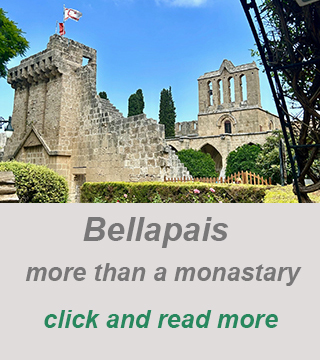Bellapais Monastery: A Historical and Cultural Gem in Cyprus
 Bellapais Monastery, located in the village of Bellapais near Kyrenia, Cyprus, is a magnificent example of Gothic architecture and a site rich in history. Known for its serene beauty and stunning views of the surrounding landscape, Bellapais Monastery is a must-visit destination for history enthusiasts, architecture lovers, and those seeking tranquility.
Bellapais Monastery, located in the village of Bellapais near Kyrenia, Cyprus, is a magnificent example of Gothic architecture and a site rich in history. Known for its serene beauty and stunning views of the surrounding landscape, Bellapais Monastery is a must-visit destination for history enthusiasts, architecture lovers, and those seeking tranquility.
Bellapais Monastery stands as a testament to the rich history and cultural heritage of Cyprus. Its Gothic architecture, historical significance, and serene beauty make it a captivating destination for visitors. Whether you’re interested in exploring its architectural marvels, attending a cultural event, or simply enjoying the tranquil surroundings, Bellapais Monastery offers a unique and enriching experience.
Foundation and Early History
Bellapais Monastery, also known as the Abbey of Peace, is one of the most significant and well-preserved examples of Gothic architecture in Cyprus. Located in the picturesque village of Bellapais, near Kyrenia, the monastery’s history dates back to the early 13th century.
- Foundation by Augustinian Monks: The monastery was established around 1205 by Augustinian monks who fled from Jerusalem after the city was captured during the Crusades. These monks were granted land by the ruling Lusignan kings of Cyprus, who were keen to support the Christian religious orders.
- Original Name: The original name of the monastery was „Abbey of Our Lady of the Mountain,“ reflecting its dedication to the Virgin Mary and its elevated location in the Kyrenia mountain range.
Lusignan Period
The monastery thrived under the Lusignan kings, who ruled Cyprus from the late 12th century until the late 15th century.
- Gothic Architecture: During this period, significant construction took place, giving the monastery its distinctive Gothic character. The Lusignans were influenced by the architectural styles of France and Italy, which is evident in the pointed arches, ribbed vaults, and detailed stone carvings.
- Expansion: The monastery complex was expanded to include the church, cloisters, refectory, and living quarters for the monks. The cloisters, with their graceful arches and serene courtyards, became a central feature of the monastery.
Venetian and Ottoman Periods
- Venetian Rule: In 1489, Cyprus came under Venetian control. The Venetians, known for their defensive structures, made few changes to the monastery but continued to support its religious functions.
- Ottoman Conquest: The Ottoman Empire conquered Cyprus in 1571. Under Ottoman rule, the monastery’s influence and wealth declined. The Ottomans confiscated much of the monastery’s property, and the number of monks dwindled.
Decline and Restoration
- Abandonment: By the 18th century, Bellapais Monastery was largely abandoned. The remaining monks left, and the buildings fell into disrepair. Local villagers used the monastery stones for building materials, further contributing to its decay.
- Rediscovery and Restoration: Interest in the monastery was revived in the 20th century. Restoration efforts began, aiming to preserve the remaining structures and stabilize the ruins. The British colonial administration in Cyprus undertook significant restoration work in the 1930s.
Modern Era
- Tourist Attraction: Today, Bellapais Monastery is a major tourist attraction in Cyprus. Visitors are drawn to its stunning Gothic architecture, historical significance, and serene setting. The monastery offers a glimpse into the island’s medieval past and the religious life of its former inhabitants.
- Cultural Hub: The monastery also serves as a cultural venue, hosting concerts, festivals, and other events. The Bellapais Music Festival, held annually, is particularly renowned, featuring performances by international artists in the monastery’s evocative surroundings.
Architectural Highlights
- Church: The heart of the monastery, the church, features beautiful Gothic arches and ribbed vaults. Its interior, though now sparse, once housed elaborate decorations and religious artifacts.
- Cloisters: The cloisters, with their tranquil courtyard, are a highlight of the monastery. The arches and columns create a harmonious and peaceful atmosphere, perfect for contemplation.
- Refectory: The refectory, where the monks once dined, is a large hall with an impressive vaulted ceiling. It now serves as a venue for events and exhibitions.
Author: Jürgen Derichs am 28. Juni 2024 13:37, category: Best places at Cyprus to visit, comments per feed RSS 2.0, comments closed.








